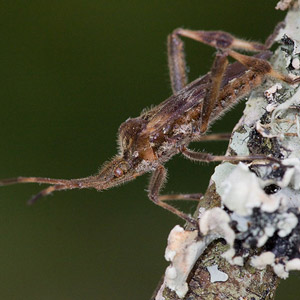Winter Bugs in Your House Are About to Wake Up!
By Chris Williams on February 25, 2014.

The western conifer seed bug
Question
I have been finding strange bugs in my house recently. Since it’s still winter outside, they must be coming from inside. They’re pretty big, almost an inch long, brownish with long feelers and long legs that have fat calves! Do you know what they are and why they’re in my house?
Answer
Well, I’ve never heard the “fat calves” part before, but you could be talking about the western conifer seed bug. This insect does have what we call “expanded tibiae” on its hind legs, which could be seen as fat calves. The flattened leg projections are somewhat in the shape of leaves and are a distinctive clue in identifying this insect.
Western conifer seed bugs are just one of the so-called fall invading insects that move into homes and other buildings when the weather gets cold. If they can get inside through cracks and crevices, they will hide in wall voids, attics, behind baseboards, and in other hidden places where they spend the winter. The western conifer seed bug is a fairly new overwintering pest for our region (despite the name, it’s also an eastern pest). Other fall invaders that you may recognize are the Asian ladybug, the boxelder bug, and the brown marmorated stink bug. Most of these are outside plant-feeding bugs that are pretty harmless inside.
I’m afraid these bugs have probably been in your home since last fall, without your knowledge, and almost certainly without your permission.
Once inside, fall-invading insects are nice and quiet and stay hidden away until they get the biological signal that spring is coming and it’s time to get back outside and procreate. Unfortunately, sometimes they get that signal prematurely and will wander out of hiding on warm, sunny days in the winter.
It won’t be long, though, before any overwintering insects in your home will appear in earnest. When they emerge from their hiding places, they are pretty sluggish and slow-moving. They usually head towards lights or windows, looking for a way out. At this point, you can help them back outside, or vacuum or sweep them up and dispose of them. Be careful that you don’t handle them roughly or crush them in the process because some of these insects will release a defensive fluid that can stain fabrics and light surfaces.
The Best Control is to Block Them From Getting In
Fall-invading insects are hard to find and control once they get inside your home because they disperse to so many hidden locations. So the trick is to keep them out of your home in the first place (see Keeping Seed Bugs Out This Fall!). You can do that by sealing up all the openings where they enter (called “pest-proofing”). Pest-proofing is one of our specialties. It’s also a good idea to call Colonial and schedule a fall perimeter treatment of your home. We treat around the foundation and lower exterior walls to intercept fall-invading insects before they can get inside.
Photo credit: oldbilluk / Foter / CC BY-NC-SA